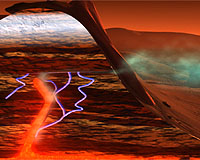 |
for Astrobiology Magazine Moffett Field CA (SPX) Dec 18, 2009 Certain environments on Earth that host life are very similar to places on Mars and other terrestrial planets, scientists have found. So if life can exist here, why not there? Nora Noffke is a geobiologist at Old Dominion University in Norfolk, Virginia. She has found evidence of microbial life all over the world - in both modern and in fossil coastal areas. Bacteria that grow on beach sand form microbial mats - organic layers that resemble carpets over the ground. Such carpets - composed of trillions of individual bacterial cells moving actively through the sand - leave characteristic traces in the beach deposits. We can study those traces in modern beaches of our Earth today. However, those bacterial traces also can become fossils that record ancient coast lines of the past. The oldest traces of such fossils date back to 3.2 billion years ago. Noffke and her colleague Sherry Cady of Portland State University in Oregon recently wrote an article in the November 2009 issue of the Geological Society of America's journal, GSA today, detailing how the melding of geology and biology can teach us about the environments most likely to host extraterrestrial life. The microbes Noffke studies are simple organisms called cyanobacteria that require no more than sunlight to grow. Organisms like this, which use the process of photosynthesis to convert sunlight to energy to live on, are called photoautotrophs. "They can live basically anywhere," she said. "They can grow directly on pure sterile sand. They don't need any soil. They gather all they need from the atmosphere and sunlight." Cyanobacteria that colonize sand are pioneer organisms that help to pave the way for more complex plants to develop by creating usable nitrogen as a byproduct. Since cyanobacteria have had such an easy time existing in austere environments on Earth, there's no reason they couldn't have lived on other planets, Noffke said. Earth's solar system neighbor, Mars, seems an especially good candidate because it is thought to have, or to have once had, liquid water. "The likelihood that there were some kind of bacteria colonizing lakes or oceans on Mars is very high," Noffke said. If it's so likely, why haven't we found evidence of life on Mars yet? "It's just a matter of continuing to search," Noffke said. "It just takes time to hit the right spot, to be lucky to find something." Noffke herself has travelled around the world looking for evidence of cyanobacteria in new and diverse locations both along modern coasts and in ancient rocks. Even on this planet with past and present life abundant, finding colonies of cyanobacteria can sometimes take time, she said. "I went to South Africa," she said. "It took weeks until we found one little spot where we actually saw something in a rock. Even on Earth you have to search for a long time to find it. Bacteria are small, which we cannot say of a whole planet such as Mars." Once you find them, the signs of cyanobacteria are unmistakable. The mat-like extent of the bacteria leaves a wrinkle pattern in the rock. The crinkle structure cannot be mimicked by anything else, and isn't easily mistaken for other processes, Noffke said. "If you'd really like to search for life elsewhere, that's what to look for first," she said. "That's the most dominant structure." Noffke and other geobiologists help the search for life beyond Earth by compiling databases of the signals life leaves in its wake. Then if an intriguing pattern is ever found in Martian rock, for example, the structure can be compared with Earthly analogues, and statistical analysis can tell whether they are sufficiently similar to prove the structure was made by living things. "We came up with a whole catalog of what we term biosignatures," Noffke said. "Those biosignatures are signals caused by life in an environment (past or present). Our biosignatures in the sand or sandstone are significant, simply because sand and sandstone is a very common deposit on Mars. We send our catalogue of fossil and modern biosignatures to NASA to provide the information what to look for." By some analyses it seems like extraterrestrial life, or at least proof of its past existence, is a sure thing, just waiting to be discovered in the solar system. But scientists still don't know all of the necessary conditions for life, nor what the spark was that started life on Earth. Until we can answer those questions, the best hope for discovering whether there is life on another planet is to look for evidence of it in the rock record, Noffke said. Noffke's catalogue of biosignatures should help future missions identify the signs of life, if they are really there to be found. Share This Article With Planet Earth
Related Links Old Dominion University Mars News and Information at MarsDaily.com Lunar Dreams and more
 Methane study favors life on Mars theory
Methane study favors life on Mars theoryLondon (UPI) Dec 15, 2009 Imperial College London scientists say they have ruled out the possibility that methane is delivered by meteorites into Mars' atmosphere. That finding, the researchers note, raises fresh hopes that the gas might be generated by life on the red planet. Scientists said methane on Mars is being constantly replenished by an unidentified source. Researchers had thought meteorites ... read more |
|
| The content herein, unless otherwise known to be public domain, are Copyright 1995-2009 - SpaceDaily. AFP and UPI Wire Stories are copyright Agence France-Presse and United Press International. ESA Portal Reports are copyright European Space Agency. All NASA sourced material is public domain. Additional copyrights may apply in whole or part to other bona fide parties. Advertising does not imply endorsement,agreement or approval of any opinions, statements or information provided by SpaceDaily on any Web page published or hosted by SpaceDaily. Privacy Statement |